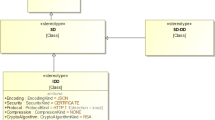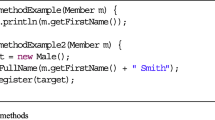Abstract
In this paper we formalize the object-oriented data model of the Chimera language. This language supports all the common features of object-oriented data models such as object identity, complex objects and user-defined operations, classes, inheritance. Constraints may be defined by means of deductive rules, used also to specify derived attributes. In addition, class attributes, operations, and constraints that collectively apply to classes are supported.
The main contribution of our work is to define a complete formal model for an object-oriented data model, and to address on a formal basis several issues deriving from the introduction of rules into an object-oriented data model.
Similar content being viewed by others
References
R. Agrawal and N. Gehani. ODE (Object Database and Environment): The Language and the Data Model. In Proc. of the ACM SIGMOD Int'l Conf. on Management of Data, pages 36–45, 1989.
H. Balsters, R. A. de By, and R. Zicari. Typed Sets as a Basis for Object-Oriented Database Schemas. In Proc. Seventh European Conference on Object-Oriented Programming, LNCS 707, 1993.
C. Beeri. Formal Models for Object Oriented Databases. In W. Kim et al., editors, Proc. First Int'l Conf. on Deductive and Object-Oriented Databases, pages 370–395, 1989.
E. Bertino, E. Ferrari, and G. Guerrini. T _Chimera: A Temporal Object-Oriented Data Model. Theory and Practice of Object Systems, 3(2):103–125, 1997.
E. Bertino and G. Guerrini. Objects with Multiple Most Specific Classes. In W. Olthoff, editor, Proc. Ninth European Conference on Object-Oriented Programming, LNCS 952, pages 102–126, 1995.
E. Bertino, G. Guerrini, and I. Merlo. Trigger Inheritance and Overriding in an Active Object Database System. In Proc. Fifth International Conference on Deductive and Object-Oriented Databases, Montreux (Switzerland), December 1997.
E. Bertino, G. Guerrini, and D. Montesi. Deductive Object Databases. In M. Tokoro and R. Pareschi, editors, Proc. Eighth European Conference on Object-Oriented Programming, LNCS 821, pages 213–235, 1994.
R. Breitl et al. The GemStone Data Management System. In W. Kim and F. H. Lochovsky, editors, Object-Oriented Concepts, Databasases, and Applications, pages 283–308. Addison-Wesley, 1989.
R. Cattel. The Object Database Standard: ODMG-93. Morgan-Kaufmann, 1996.
S. Ceri and R. Manthey. Consolidated Specification of Chimera. Technical Report IDEA.DE.2P.006.01, ESPRIT Project 6333, November 1993.
S. Ceri and R. Manthey. Chimera: A Model and Language for active DOOD Systems. In J. Eder and L. Kalinichenko, editors, Extending Information System Technology, Proc. Second International East/West Database Workshop, pages 9–21, 1994.
D. Chamberlin. Using the New DB2-IBM's Object-Relational Database System. Morgan-Kaufmann, 1996.
O. Deux et al. The Story of 02. IEEE Transactions on Knowledge and Data Engineering, 2(1):91–108, 1990.
D. H. Fishman et al. Overview of the Iris DBMS. In W. Kim and F. H. Lochovsky, editors, Object-Oriented Concepts, Databases, and Applications, pages 219–250. Addison-Wesley, 1989.
L. J. Gallagher. Object SQL: Language Extensions for Object Data Management. In Proc. First International Conference on Information and Knowledge Management, 1992.
N. Gehani and H. Jagadish. Ode as an Active Database: Constraints and Triggers. In Proc. Seventeenth Int'l Conf. on Very Large Data Bases, pages 327–336, 1991.
G. Guerrini. An Active and Deductive Object-Oriented Data Model. PhD thesis, Università di Genova, February 1998.
G. Guerrini, E. Bertino, and R. Bal. A Formal Definition of the Chimera Object-Oriented Data Model. Technical Report IDEA.DE.2P.011.01, ESPRIT Project 6333, May 1994. Extended version of this paper.
G. Guerrini, E. Bertino, B. Catania, and J. Garcia-Molina. A Formal Model of Views for Object-Oriented Database Systems. Theory and Practice of Object Systems, 3(3):157–183, 1997.
Illustra Information Technologies, Oakland, California. Illustra User's Guide. Release 2.1.
W. Kim et al. Features of the ORION Object-Oriented Database System. InW. Kim and F. H. Lochovsky, editors, Object-Oriented Concepts, Databasases, and Applications, pages 251–282. Addison-Wesley, 1989.
M. Scholl and H. Schek. A Relational Object Model. In S. Abiteboul and P.C. Kanellakis, editors, Proc. Third Int'l Conf. on Database Theory, LNCS 470, pages 89–105, 1990.
Author information
Authors and Affiliations
Rights and permissions
About this article
Cite this article
Guerrini, G., Bertino, E. & Bal, R. A Formal Definition of the Chimera Object-Oriented Data Model. Journal of Intelligent Information Systems 11, 5–40 (1998). https://doi.org/10.1023/A:1008618309981
Issue Date:
DOI: https://doi.org/10.1023/A:1008618309981




